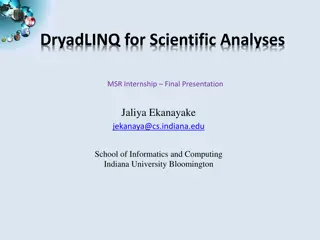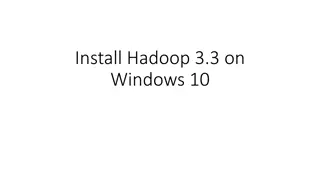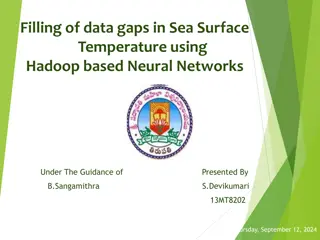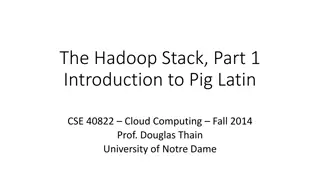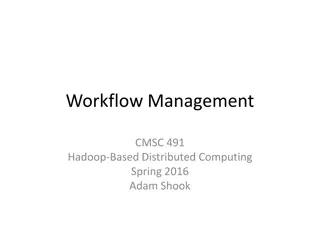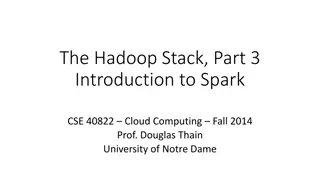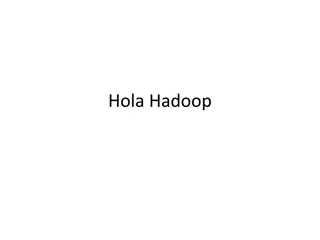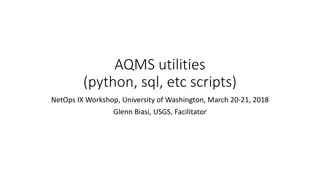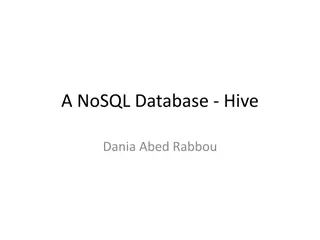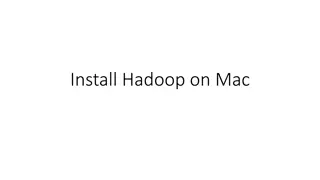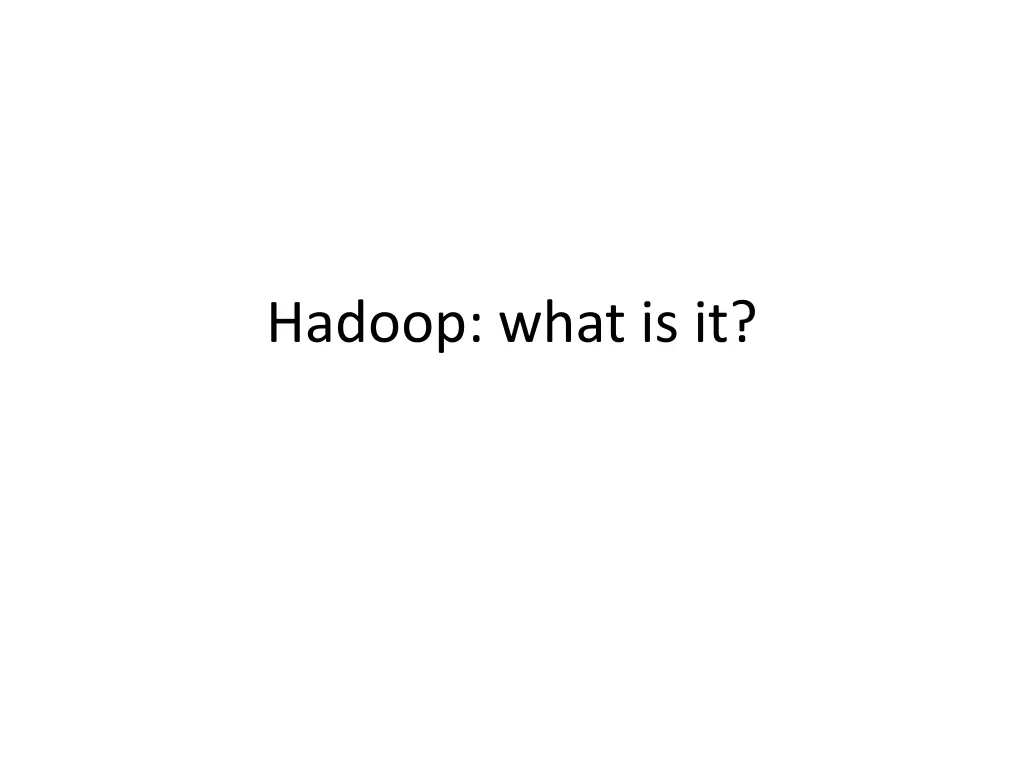
Understanding Hadoop: Data Processing and Management Overview
Learn about Hadoop, a powerful framework for managing big data, processing tasks, and handling hardware failures. Explore its features, issues, comparison with other approaches, MapReduce core ideas, and scalability considerations.
Download Presentation

Please find below an Image/Link to download the presentation.
The content on the website is provided AS IS for your information and personal use only. It may not be sold, licensed, or shared on other websites without obtaining consent from the author. If you encounter any issues during the download, it is possible that the publisher has removed the file from their server.
You are allowed to download the files provided on this website for personal or commercial use, subject to the condition that they are used lawfully. All files are the property of their respective owners.
The content on the website is provided AS IS for your information and personal use only. It may not be sold, licensed, or shared on other websites without obtaining consent from the author.
E N D
Presentation Transcript
Hadoop manages: processor time memory disk space network bandwidth Does not have a security model Can handle HW failure
Issues: race conditions synchronization deadlock i.e., same issues as distributed OS & distributed filesystem
Hadoop vs other existing approaches Grid computing: (What is this?) e.g. Condor MPI model is more complicated does not automatically distribute data requires separate managed SAN
Hadoop: simplified programming model data distributed as it is loaded HDFS splits large data files across machines HDFS replicates data failure causes additional replication
MapReduce Core idea: records are processed in isolation Benefit: reduced communication Jargon: mapper task that processes records Reducer task that aggregates results from mappers
How is the previous picture different from normal grid/cluster computing? Grid/cluster: Programmer manages communication via MPI vs Hadoop: communication is implicit Hadoop manages data transfer and cluster topology issues
Scalability Hadoop overhead MPI does better for small numbers of nodes Hadoop flat scalabity pays off with large data Little extra work to go from few to many nodes MPI requires explicit refactoring from small to larger number of nodes
Hadoop Distributed File System NFS: the Network File System Saw this in OS class Supports file system exporting Supports mounting of remote file system
NFS Mounting: Three Independent File Systems Operating System Concepts
Mounting in NFS Mounts Cascading mounts Operating System Concepts
NFS Mount Protocol Establishes logical connection between server and client. Mount operation: name of remote directory & name of server Mount request is mapped to corresponding RPC and forwarded to mount server running on server machine. Export list specifies local file systems that server exports for mounting, along with names of machines that are permitted to mount them. Operating System Concepts
NFS Mount Protocol server returns a file handle a key for further accesses. File handle a file-system identifier, and an inode number to identify the mounted directory The mount operation changes only the user s view and does not affect the server side. Operating System Concepts
NFS Advantages Transparency clients unaware of local vs remote Standard operations - open(), close(), fread(), etc. NFS disadvantages Files in an NFS volume reside on a single machine No reliability guarantees if that machine goes down All clients must go to this machine to retrieve their data
Hadoop Distributed File System HDFS Advantages: designed to store terabytes or petabytes data spread across a large number of machines supports much larger file sizes than NFS stores data reliably (replication)
Hadoop Distributed File System HDFS Advantages: provides fast, scalable access serve more clients by adding more machines integrates with MapReduce local computation
Hadoop Distributed File System HDFS Disadvantages Not as general-purpose as NFS Design restricts use to a particular class of applications HDFS optimized for streaming read performance not good at random access
Hadoop Distributed File System HDFS Disadvantages Write once read many model Updating a files after it has been closed is not supported (can t append data) System does not provide a mechanism for local caching of data
Hadoop Distributed File System HDFS block-structured file system File broken into blocks distributed among DataNodes DataNodes machines used to store data blocks
Hadoop Distributed File System Target machines chosen randomly on a block-by-block basis Supports file sizes far larger than a single-machine DFS Each block replicated across a number of machines (3, by default)
Hadoop Distributed File System Expects large file size Small number of large files Hundreds of MB to GB each Expects sequential access Default block size in HDFS is 64MB Result: Reduces amount of metadata storage per file Supports fast streaming of data (large amounts of contiguous data)
Hadoop Distributed File System HDFS expects to read a block start-to-finish Useful for MapReduce Not good for random access Not a good general purpose file system
Hadoop Distributed File System HDFS files are NOT part of the ordinary file system HDFS files are in separate name space Not possible to interact with files using ls, cp, mv, etc. Don t worry: HDFS provides similar utilities
Hadoop Distributed File System Meta data handled by NameNode Deal with synchronization by only allowing one machine to handle it Store meta data for entire file system Not much data: file names, permissions, & locations of each block of each file
Hadoop Distributed File System What happens if the NameNode fails? Bigger problem than failed DataNode Better be using RAID ;-) Cluster is kaput until NameNode restored Not exactly relevant but: DataNodes are more likely to fail. Why?
Working with HDFS Most commands use hadoop General format: user@machine:hadoop$ hadoop moduleName-cmdargs... Where moduleName specifies HDFS functionality Where cmd specifies which command
Working with HDFS Listing files: [student@sandbox ~]$ hadoop fs -ls Found 2 items drwx------ - student hdfs 0 2017-08-03 06:00 .Trash drwx------ - student hdfs 0 2016-07-28 14:02 .staging Note: not much listed!!! -ls command returns zilch Why? No concept of current working directory With NO arguments, -ls refers to home directory in HDFS This is not /home/rose
Working with HDFS Try specifying a directory [student@sandbox ~]$ hadoop fs -ls / Found 11 items drwxrwxrwx - yarn hadoop 0 2015-10-21 17:47 /app-logs drwxr-xr-x - hdfs hdfs 0 2015-08-20 08:38 /apps drwxr-xr-x - root hdfs 0 2015-11-09 16:23 /data drwxr-xr-x - hdfs hdfs 0 2015-08-20 08:56 /demo drwxr-xr-x - hdfs hdfs 0 2015-08-20 08:33 /hdp drwxr-xr-x - mapred hdfs 0 2015-08-20 08:33 /mapred drwxrwxrwx - mapred hadoop 0 2015-08-20 08:33 /mr-history drwxr-xr-x - hdfs hdfs 0 2015-08-20 08:50 /ranger drwxrwxrwx - root hdfs 0 2015-11-09 18:37 /share drwxrwxrwx - hdfs hdfs 0 2015-11-09 18:42 /tmp drwxr-xr-x - hdfs hdfs 0 2015-11-09 18:39 /user
Loading data First create a directory [student@sandbox ~]$ hadoop fs -mkdir /user/rose Next upload a file (uploads to /user/rose) [student@sandbox ~]$ hadoop fs -put InterestingFile.txt /user/rose/ Verify the file is in HDFS [student@sandbox ~]$ hadoop dfs -ls /user/rose
Loading data You can also put multiple files Consider a directory: myfiles Contents: Bayes.csv FBS2016.csv Subdirectory: subdir/ Content: iris.csv Let s put all of these file in the HDFS [student@sandbox ~]$ hadoop fs -put myfiles /user/rose [student@sandbox ~]$ hadoop fs -ls /user/rose Found 1 items drwxr-xr-x - student hdfs 0 2017-11-01 20:58 /user/rose/myfiles [student@sandbox ~]$ hadoop fs -ls /user/rose/myfiles Found 3 items -rw-r--r-- 1 student hdfs 247 2017-11-01 20:58 /user/rose/myfiles/Bayes.csv -rw-r--r-- 1 student hdfs 62369 2017-11-01 20:58 /user/rose/myfiles/FBS2016.csv drwxr-xr-x - student hdfs 0 2017-11-01 20:58 /user/rose/myfiles/subdir
Loading data There was something new in the directory listing: /user/rose/myfiles/file1.txt <r 1> 186731 2008-06-12 20:59 rw-r--r-- hduser supergroup Q: What does <r 1> mean? A: The number of replicas of this file (Note: when I tried this on saluda there was no <r 1> )
Getting data from HDFS We can use cat to display a file to stdout hduser@saluda:/opt/hadoop$ hadoop fs -cat /user/rose/README.txt We can get files from the Hadoop File System hduser@saluda:/opt/hadoop$ hadoop fs -get /user/rose/README.txt AAAREADME.txt hduser@saluda:/opt/hadoop$ ls AAAREADME.txt Bin build.xml c++ CHANGES.txt Conf Contrib hadoop-ant-1.0.4.jar hadoop-client-1.0.4.jar hadoop-core-1.0.4.jar hadoop-examples-1.0.4.jar hadoop-minicluster-1.0.4.jar LICENSE.txt hadoop-test-1.0.4.jar hadoop-tools-1.0.4.jar ivy ivy.xml lib libexec README.txt sbin share src webapps logs NOTICE.txt
Other commands Hadoop will list all commands that can be run with the FS Shell with the command: hduser@saluda:/opt/hadoop$ hadoop fs

